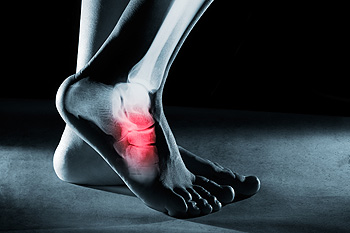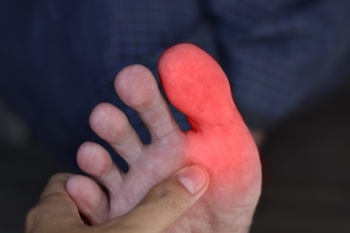June 2024
Definition and Causes of Foot Stress Fractures

A foot stress fracture is a small crack or severe bruising within a bone, often resulting from repetitive force or overuse rather than a single traumatic event. Common causes include high-impact sports, sudden increases in physical activity, and wearing inadequate footwear. Stress fractures frequently occur in the weight-bearing bones of the foot, such as the metatarsals. Symptoms include pain that worsens with activity and diminishes with rest, swelling, and tenderness at the fracture site. Recovery time for a foot stress fracture typically ranges from six to eight weeks, depending on the severity and adherence to treatment. Proper rest, wearing supportive footwear, and gradually returning to activities are essential for healing. In some cases, immobilization with a boot or crutches may be necessary. If your foot hurts, it is suggested that you visit a podiatrist who can accurately diagnose and treat stress fractures.
Stress fractures occur when there is a tiny crack within a bone. To learn more, contact John McGhan, DPM from Gold Canyon Foot & Ankle. Our doctor can provide the care you need to keep you pain free and on your feet.
How Are They Caused?
Stress fractures are the result of repetitive force being placed on the bone. Since the lower leg and feet often carry most of the body’s weight, stress fractures are likely to occur in these areas. If you rush into a new exercise, you are more likely to develop a stress fracture since you are starting too much, too soon. Pain resulting from stress fractures may go unnoticed at first, however it may start to worsen over time.
Risk Factors
- Gender – They are more commonly found in women compared to men.
- Foot Problems – People with unusual arches in their feet are more likely to develop stress fractures.
- Certain Sports – Dancers, gymnasts, tennis players, runners, and basketball players are more likely to develop stress fractures.
- Lack of Nutrients – A lack of vitamin D and calcium may weaken the bones and make you more prone to stress fractures
- Weak Bones – Osteoporosis can weaken the bones therefore resulting in stress fractures
Stress fractures do not always heal properly, so it is important that you seek help from a podiatrist if you suspect you may have one. Ignoring your stress fracture may cause it to worsen, and you may develop chronic pain as well as additional fractures.
If you have any questions, please feel free to contact our office located in Gold Canyon, AZ . We offer the newest diagnostic and treatment technologies for all your foot care needs.
Facts About Toe Numbness and Tingling

Toe numbness and tingling, often described as a pins-and-needles sensation, can arise from various causes. Commonly, it results from poor circulation, nerve compression, or injury. Prolonged pressure on the nerves, such as from wearing tight shoes or sitting in one position for too long, can lead to temporary numbness. Medical conditions like diabetes, peripheral neuropathy, or multiple sclerosis can also cause these symptoms. Additionally, deficiencies in vitamins such as B12, or mineral imbalances, may contribute to nerve problems. Recognizing the underlying cause is essential for effective treatment. If numbness and tingling persist or are accompanied by other symptoms, like pain or muscle weakness, it is important to seek medical advice from a podiatrist. If you have these sensations in your feet or toes, it is suggested that you visit this foot doctor for a diagnosis and treatment.
Toe pain can disrupt your daily activities. If you have any concerns, contact John McGhan, DPM of Gold Canyon Foot & Ankle. Our doctor can provide the care you need to keep you pain-free and on your feet.
What Causes Toe Pain?
Most severe toe pain is caused due to a sports injury, trauma from dropping something heavy on the toe, or bumping into something rigid. Other problems can develop over time for various reasons.
Toe pain can be caused by one or more ailments. The most common include:
- Trauma
- Sports injury
- Wearing shoes that are too tight
- Arthritis
- Gout
- Corns and calluses
- Hammertoe
- Bunions
- Blisters
- Ingrown toenails
- Sprains
- Fractures (broken bones)
- Dislocations
When to See a Podiatrist
- Severe pain
- Persistent pain that lasts more than a week
- Signs of infection
- Continued swelling
- Pain that prevents walking
Diagnosis
In many cases the cause of toe pain is obvious, but in others, a podiatrist may want to use more advanced methods to determine the problem. These can range from simple visual inspections and sensation tests to X-rays and MRI scans. Prior medical history, family medical history, and any recent physical traumatic events will all be taken into consideration for a proper diagnosis.
Treatment
Treatments for toe pain and injuries vary and may include shoe inserts, padding, taping, medicines, injections, and in some cases, surgery. If you believe that you have broken a toe, please see a podiatrist as soon as possible.
If you have any questions please feel free to contact our office located in Gold Canyon, AZ . We offer the newest diagnostic tools and technology to treat your foot and ankle needs.
How Seniors Can Prevent Falls in the Home

For seniors, falls can pose significant risks to health and independence, and can seriously impact the feet, necessitating the need to make fall prevention techniques in the home important. Start by ensuring adequate lighting throughout the house, especially in hallways, staircases, and bathrooms, to enhance visibility and reduce tripping hazards. Remove clutter and secure loose rugs or carpets to prevent slips and falls. Install grab bars in bathrooms and near toilets and showers to provide stability and support. Additionally, consider adding non-slip mats or adhesive strips to bathtub and shower floors. Keep commonly used items within easy reach to avoid overreaching or straining. Regular exercise to improve strength, balance, and flexibility can also reduce the risk of falls. Ensure that footwear fits well and provides proper support and traction. Regularly review medications with a healthcare provider to identify potential side effects that may increase fall risk. If falling has happened and foot conditions have arisen, it is suggested that you consult a podiatrist who can offer you effective treatment and additional prevention methods.
Preventing falls among the elderly is very important. If you are older and have fallen or fear that you are prone to falling, consult with John McGhan, DPM from Gold Canyon Foot & Ankle. Our doctor will assess your condition and provide you with quality advice and care.
Every 11 seconds, an elderly American is being treated in an emergency room for a fall related injury. Falls are the leading cause of head and hip injuries for those 65 and older. Due to decreases in strength, balance, senses, and lack of awareness, elderly persons are very susceptible to falling. Thankfully, there are a number of things older persons can do to prevent falls.
How to Prevent Falls
Some effective methods that older persons can do to prevent falls include:
- Enrolling in strength and balance exercise program to increase balance and strength
- Periodically having your sight and hearing checked
- Discuss any medications you have with a doctor to see if it increases the risk of falling
- Clearing the house of falling hazards and installing devices like grab bars and railings
- Utilizing a walker or cane
- Wearing shoes that provide good support and cushioning
- Talking to family members about falling and increasing awareness
Falling can be a traumatic and embarrassing experience for elderly persons; this can make them less willing to leave the house, and less willing to talk to someone about their fears of falling. Doing such things, however, will increase the likelihood of tripping or losing one’s balance. Knowing the causes of falling and how to prevent them is the best way to mitigate the risk of serious injury.
If you have any questions, please feel free to contact our office located in Gold Canyon, AZ . We offer the newest diagnostic and treatment technologies for all your foot care needs.
Flat Feet and Overpronation
 Flat feet, a condition where the arches of the feet touch the ground when you stand, can lead to overpronation. Overpronation occurs when the ankles roll excessively inward with each step during walking or running. This can cause additional strain on the ankles, knees, and hips. Overpronation can also increase the risk of injuries and discomfort due to improper alignment and distribution of body weight. People with flat feet may experience fatigue in their feet and legs, and suffer from pain in the heel or arch area. To help manage symptoms of flat feet and any issues resulting from overpronation, a podiatrist, or foot doctor, may recommend orthotic devices. These are insoles that fit into shoes to provide support for the arches, correct the pronation, and enhance overall foot function. Proper footwear that offers stability and support is also important to effectively manage overpronation. Regular check-ups with a podiatrist can ensure that individuals with flat feet receive the necessary support and guidance to prevent any issues. If you have flat feet, or suspect overpronation when walking, it is suggested you make an appointment with a podiatrist for a full exam and possible gait analysis.
Flat feet, a condition where the arches of the feet touch the ground when you stand, can lead to overpronation. Overpronation occurs when the ankles roll excessively inward with each step during walking or running. This can cause additional strain on the ankles, knees, and hips. Overpronation can also increase the risk of injuries and discomfort due to improper alignment and distribution of body weight. People with flat feet may experience fatigue in their feet and legs, and suffer from pain in the heel or arch area. To help manage symptoms of flat feet and any issues resulting from overpronation, a podiatrist, or foot doctor, may recommend orthotic devices. These are insoles that fit into shoes to provide support for the arches, correct the pronation, and enhance overall foot function. Proper footwear that offers stability and support is also important to effectively manage overpronation. Regular check-ups with a podiatrist can ensure that individuals with flat feet receive the necessary support and guidance to prevent any issues. If you have flat feet, or suspect overpronation when walking, it is suggested you make an appointment with a podiatrist for a full exam and possible gait analysis.
Flatfoot is a condition many people suffer from. If you have flat feet, contact John McGhan, DPM from Gold Canyon Foot & Ankle. Our doctor will treat your foot and ankle needs.
What Are Flat Feet?
Flatfoot is a condition in which the arch of the foot is depressed and the sole of the foot is almost completely in contact with the ground. About 20-30% of the population generally has flat feet because their arches never formed during growth.
Conditions & Problems:
Having flat feet makes it difficult to run or walk because of the stress placed on the ankles.
Alignment – The general alignment of your legs can be disrupted, because the ankles move inward which can cause major discomfort.
Knees – If you have complications with your knees, flat feet can be a contributor to arthritis in that area.
Symptoms
- Pain around the heel or arch area
- Trouble standing on the tip toe
- Swelling around the inside of the ankle
- Flat look to one or both feet
- Having your shoes feel uneven when worn
Treatment
If you are experiencing pain and stress on the foot you may weaken the posterior tibial tendon, which runs around the inside of the ankle.
If you have any questions please feel free to contact our office located in Gold Canyon, AZ . We offer the newest diagnostic and treatment technologies for all your foot and ankle needs.

